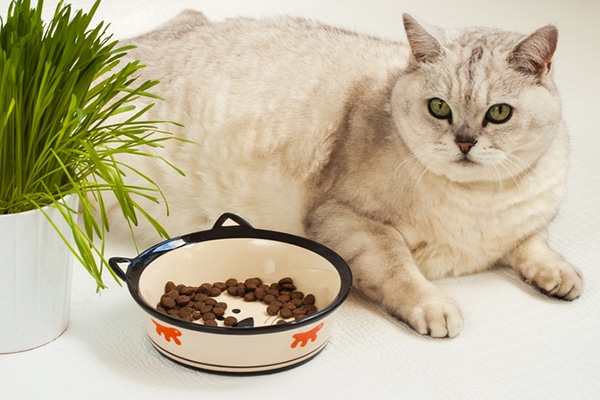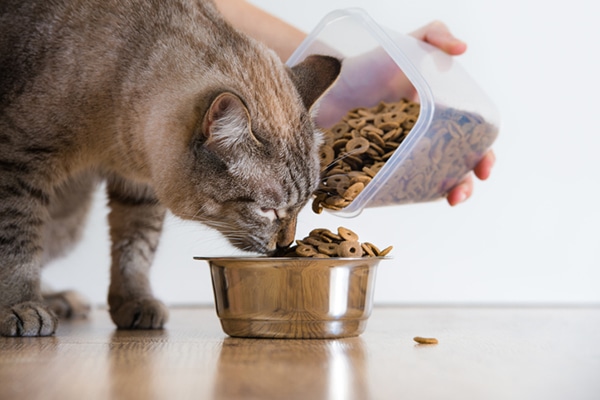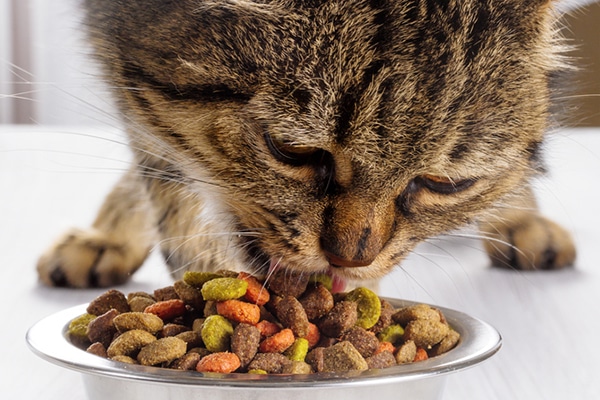How you feed your cat matters as much as what you feed your cat. Free feeding cats, which is defined as filling your cat’s bowl with dry food and leaving it out for your cat at all times, is a common practice among many cat parents. Your cat never has to worry about being hungry because there is always food in the bowl. This method is easy and convenient for pet parents, but it’s not the best option for most cats.
The cons to free feeding cats

“One of the cons to free feeding cats is that they can easily become obese, particularly if they’re not privileged to environmental enrichment — things in their environment that provide them [with] activity and mental engagement,” explains Tracey Jensen, D.V.M., Dipl. ABVP, founding partner of Wellington Veterinary Hospital in Wellington, Colorado. “Obesity is at epidemic proportions in cats, and obese felines are prone to a couple of different things — probably the most dangerous and expensive is diabetes.”
Many cats live indoors, which is great because it’s the safest place for them. However, indoor cats tend to get less exercise and, because of this, might take in too many calories from their food. Some cats eat too much out of boredom; others just love food and simply can’t stop eating if food is available at all times.
Free feeding also factors into the dry food vs. wet food debate. Since wet food does not stay fresh for that long, most pet parents who free feed cats choose dry food. Read about the pros and cons of both wet and dry cat food here.
Free feeding isn’t in your cat’s DNA
“Cats aren’t grazers, they’re hunters,” Dr. Jensen says. Cats in the wild eat much differently than pet cats. Rather than eating two big meals a day like most dogs, or nibbling on their food all day long, wild cats hunt or forage many times a day. They expend energy to get their food, eat a small meal and then have a period of rest (think of lions napping under a tree while their bellies digest that gazelle they just caught and ate).
After this period of rest, they have another period of activity, capture or forage for food again and then eat another meal. This cycle repeats itself several times throughout the day.
So, what is the ideal cat feeding schedule?

“An ideal way to feed a cat would be to feed them three to four small meals throughout the day,” Dr. Jensen says — although she admits that this method isn’t easy for pet parents who work full time outside of the home.
An automatic pet feeder may help cat guardians time their kitty’s meals, even when they’re away from home. Program the timer on the feeder, and every three to four hours, a measured amount of food gets deposited into your cat’s bowl. “That’s one way to still be able to provide your cat [with] frequent, small meals and not allow them to overindulge,’ Dr. Jensen explains. “It’s also part of the environmental enrichment, so it serves two purposes.”
The amount you feed your cat matters most
No matter how you choose to feed your cat, it’s important to calculate how much food she should be eating in a day and measure the food with a measuring cup. Keep in mind that the suggested amounts listed on the label are often too much for the typical house cat. Unless your cat is extremely active, use the suggested amount as a starting point, but lower it a bit.
Talk to your veterinarian to figure out exactly how much your cat should eat from a particular brand. Bring the bag of food with you to your appointment so your vet can make the calculation based on the caloric density of that particular food and take into consideration your cat’s current weight, ideal weight and other factors.
“Free feeding is easy, and it’s convenient, but unless you have one of the very rare cats that can meter their own calorie intake against calorie expenditure, you run a very real risk of them becoming obese,” Dr. Jensen states. “Cats are no different than people — once you put the weight on, it is really hard to get it off of them.”
Tell us: What do you think about free feeding cats? What feeding schedule are your cats on? What do you feed your cats?
Thumbnail: Photography ©g215 | Thinkstock.
Read more about feeding cats on Catster.com:








